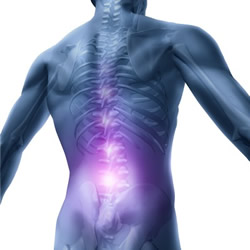 A strong, functioning back is vital to the pursuit of any athletic endeavor. If you are an athlete suffering from low back problems, what are you actively doing to overcome those problems?
A strong, functioning back is vital to the pursuit of any athletic endeavor. If you are an athlete suffering from low back problems, what are you actively doing to overcome those problems?
If your only answer is ?rest? or ?abstaining from activity,? consider that inactivity or simply resting fails to achieve what you need most?stronger tissues.
Functional strength exercises that focus on improving core postural stability?such as the one featured in the video below?should form an important component of any athlete?s repertoire (along with attention to proper posture while sitting and standing) to ensure a healthy and strong back and spine.
The article below from the current issue of ACSM?s Health & Fitness Journal provides some additional tips for how to deal with low back pain, including the need to stay active.
By Brad A. Roy, Ph.D., FACSM, FACHE and Greg Vanichkachorn, M.D.
Low back pain is one of the most prevalent medical complaints, affecting nearly every American at some point in his or her lifetime. At any given time, it is estimated that up to one third of the population is experiencing some form of back discomfort that impacts quality of life by interfering with recreational activities, daily living routines, and a person?s ability to work productively. Moreover, it is one of the most common reasons that people seek care from medical providers.
Despite this high prevalence for years, the treatment of back pain still remains nebulous at best. Many providers consider themselves inadequately trained to care for back pain, and subsequently, treatment paradigms are often based on anecdotal rather than evidence-based medicine?sometimes with injurious effects. In fact, one of the most common recommendations for the treatment of back pain is an example of previous dogma versus current evidence: that back pain should be treated with rest.
Bed Rest and Activity Modification
Recent research indicates that excessive activity restrictions are in fact the opposite of what a painful back needs most. When outcomes from patients treated with bed rest are compared with those of patients who continued with work/activity despite pain, faster recoveries occurred for the activity group. In addition, cost analysis studies of back pain indicate that early return to work and physical activity often results in lower health care costs.
Acute or short-term low back pain typically lasts from a few days to a few weeks and is usually mechanical in nature and not caused by serious conditions such as herniated disks, spinal stenosis, or fractures. Typical causes are trauma (e.g., sports injury, lifting, bending, or reaching), disorders such as arthritis, and aging. Periodically, low back pain occurs for no specific identifiable reason. Symptoms vary, ranging from muscle ache and tightness to shooting or stabbing pain that can radiate to other parts of the body, such as the legs. Although symptoms can be severe for a few days, they will often significantly improve within 2 to 6 weeks.
Staying Active is Important
Exercise is an important cornerstone in both the prevention and treatment of low back pain. Unfortunately, people experiencing the pain and stiffness associated with low back pain have a strong tendency to avoid physical activity often caused by fear of exacerbating symptoms and causing permanent damage. However, in most cases, avoidance of movement prolongs the recovery process and, in some people, increases the likelihood of developing depression, perceived disability, and ultimately, chronic low back pain.
Strained muscles need their normal motion and stretching to heal. Moreover, over restriction of activities can result in spasm and constriction in connective tissues, resulting in worsened pain and function. Although there is no single exercise program that fits all people with low back pain, cardiovascular training, resistance training, and basic core back exercise are the primary components and should be performed on a regular basis with careful attention to proper movement technique.
Although some forms of back pain, such as pain after trauma or back pain with bowel/bladder symptoms, may require more than moderate activity restriction, such scenarios are rare compared with the more common low back pain experienced as part of life. Not all low back pain requires medical attention; however, when symptoms persist for more than 14 days, it may be time to be evaluated by a medical provider who can provide appropriate guidance regarding physical activity recommendations and other potential treatment options.
For most people, the prognosis for low back pain is excellent, and recovery can be enhanced by resisting the temptation to avoid physical activity. So, the next time back pain strikes, consider striking back with continued activity; early return to activity/work can lead to a faster return to function and resolution of pain.
Brad A. Roy, Ph.D., FACSM, FACHE, is an administrator/executive director at Kalispell Regional Medical Center. He is responsible for The Summit Medical Fitness Center, a 114,800 sq. ft. medical fitness center located in Kalispell, Montana, and a number of other hospital departments. He is the editor of the Medical Fitness Association?s Standards and Guidelines for Medical Fitness Center Facilities and a past board chairman for the Medical Fitness Association.
Greg Vanichkachorn, M.D., is a board-certified family physician that practices occupational medicine in Montana. As an endurance athlete, he is an avid proponent of Exercise is Medicine, and he enjoys helping his patients realize the benefits of regular physical activity.
ACSM?s Health & Fitness Journal ? Volume 17, Number 2
? 2013 American College of Sports Medicine
Reprint permission is granted to subscribers of ACSM?s Health & Fitness Journal
Source: http://www.alpfitness.com/simply-resting-that-pain-in-the-back-is-not-a-sufficient-plan-of-action/
felix hernandez julia child Ron Palillo Chad Johnson Twitter Helen Gurley Brown Kathi Goertzen Johnny Pesky
No comments:
Post a Comment
Note: Only a member of this blog may post a comment.